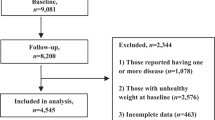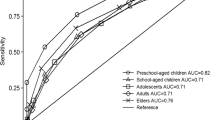Abstract
Objective: To assess the validity of two diet quality indexes—food variety score (FVS) and diet diversity score (DDS) in Western Mali.
Design: In two separate studies (A and B), FVS and DDS were derived from a food frequency questionnaire (FFQ) and were compared with the same scores and with measures of nutrient adequacy derived from 2-day weighed records (WR).
Setting: Two rural, adjacent villages in Mali, West Africa.
Subjects: In study A (1996), 48 women and 27 men (15–59 y) participated. Study B (1999) included 34 women and 36 men (15–45 y).
Results: Spearman's correlation coefficients between FVS from the FFQ and WR for men were 0.5 in study A and 0.4 in study B. The corresponding correlations for DDS were 0.2 and 0.4, respectively. Correlations for women were lower, especially in study B. Classification into quartiles was also best for men. Correlations for the two diet variety scores from the FFQ with nutrient adequacy from the WR in study A were about 0.3 for men, but lower for women. In study B, these correlations were around 0.5 for men, whereas for women there was no association.
Conclusions: FVS and DDS can be assessed by our FFQ. The two diet variety scores reflect diet quality and are simple tools that can be used for monitoring. The validation study gave better results for men than for women, which has implications for further use of these instruments.
Sponsorship: The Norwegian Research Council and The Stromme Foundation funded the project.
This is a preview of subscription content, access via your institution
Access options
Subscribe to this journal
Receive 12 print issues and online access
$259.00 per year
only $21.58 per issue
Buy this article
- Purchase on Springer Link
- Instant access to full article PDF
Prices may be subject to local taxes which are calculated during checkout


Similar content being viewed by others
References
Altman DG (1997): Practical Statistics for Medical Research. London: Chapman & Hall.
Andersen LF, Nes M, Lillegaard IT, Sandstad B & Bjørneboe GEA (1995): Evaluation of a quantitative food frequency questionnaire used in a group of Norwegian adolescents. Eur. J. Clin. Nutr. 49, 553–554.
Black AE (2000): The sensitivity and specificity of the Goldberg cut-off for EI:BMR for identifying diet reports of poor validity. Eur. J. Clin. Nutr. 54, 395–404.
Coulston AM (2001): The search continues for a tool to evaluate dietary quality. Am. J. Clin. Nutr. 74, 417.
de Guzman MPE & Molano WL (1994): Nutrition indicators for development: priority and intervention efforts. Food Nutr. Bull. 15, 250–256.
Diallo F, Diarra M, Ouattara F, Hatløy A, Oshaug A, Torheim LE & Barikmo I (1998): Rapport de l'enquête de base, Oussoubidiania et Ouassala, Bafoulabé Cercle, 1997. Oslo: Programme de collaboration PIDEB/INRSP/Université d'Oslo.
Drewnowski A, Henderson SA, Shore AB, Fischler C, Preziosi P & Hercberg S (1996): Diet quality and dietary diversity in France: implications for the French paradox. J. Am. Diet. Assoc. 96, 663–669.
FAO (2001): The State of Food Insecurity in the World 2001. Rome: Food and Agriculture Organization of the United Nations.
FAO & WHO (1994): Fats and Oils in Human Nutrition. Report of a joint FAO/WHO Expert Consultation, FAO Food and Nutrition Paper no. 57. Rome: Food and Agriculture Organization of the United Nations.
FAO & WHO (2001): Human Vitamin and Mineral Requirements. Report of a joint FAO/WHO Expert Consultation, Rome: Food and Agriculture Organization of the United Nations.
FAO, WHO & UNU (1985): Energy and Protein Requirements. Report of a joint FAO/WHO/UNU Expert Consultation, Technical Report Series no. 724. Geneva: World Health Organization.
Garrow JS (1995): Editorial. Eur. J. Clin. Nutr. 49, 231–232.
Goldberg GR, Black AE, Jebb SA, Cole TJ, Murgatroyd PR, Coward WA & Prentice AM (1991): Critical evaluation of energy intake data using fundamental principles of energy physiology: 1. Derivation of cut-off limits to identify under-recording. Eur. J. Clin. Nutr. 45, 569–581.
Goldbohm RA, van den Brandt PA, Brants HAM, van't Veer P, Al M, Sturmans F & Hermus RJJ (1994): Validation of a dietary questionnaire used in a large-scale prospective cohort study on diet and cancer. Eur. J. Clin. Nutr. 48, 253–265.
Guthrie HA & Scheer JC (1981): Validity of a dietary score for assessing nutrient adequacy. J. Am. Diet. Assoc. 78, 240–245.
Haddad L, Kennedy E & Sullivan J (1994): Choice of indicators for food security and nutrition monitoring. Food Policy 19, 329–343.
Hatløy A, Hallund J, Diarra MM & Oshaug A (2000): Food variety, socio-economic status and nutritional status in urban and rural areas in Koutiala (Mali). Public Health Nutr. 3, 57–65.
Hatløy A, Torheim LE & Oshaug A (1998): Food variety—a good indicator of nutritional adequacy of the diet? A case study from an urban area in Mali, West Africa. Eur. J. Clin. Nutr. 52, 891–898.
Hebert JR, Gupta PC, Bhonsle RB, Sinor PN, Mehta H & Mehta FS (1999): Development and testing of a quantitative food frequency questionnaire for use in Gujarat, India. Public Health Nutr. 2, 39–50.
Hu FB, Rimm E, Smith-Warner SA, Feskameh D, Stampfer MJ, Aschemo A, Sampson L & Willett WC (1999): Reproducibility and validity of dietary patterns assessed with a food-frequency questionnaire. Am. J. Clin. Nutr. 69, 243–249.
Johnson RK, Soultanakis RP & Matthews DE (1998): Literacy and body fatness are associated with underreporting of energy intake in US low-income women using the multiple-pass 24-hour recall: a doubly labelled water study. J. Am. Diet. Assoc. 98, 1136–1140.
Kant AK (1996): Indexes of overall diet quality: a review. J. Am. Diet. Assoc. 96, 585–791.
Kant AK & Graubard BI (1999): Variability in selected indexes of overall diet quality. Int. J. Vitamin Nutr. Res. 69, 419–427.
Kennedy ET, Ohls F, Carlson S & Fleming K (1995): The healthy eating index: design and applications. J. Am. Diet. Assoc. 95, 1103–1108.
Krebs-Smith SM, Smiciklas-Wright H, Guthrie HA & Krebs-Smith J (1987): The effects of variety in food choices on dietary quality. J. Am. Diet. Assoc. 87, 897–903.
Kristal AR, Feng Z, Coates RJ, Oberman A & George V (1997): Association of race/ethnicity, education, and dietary intervention with the validity and reliability of a food frequency questionnaire. Am. J. Epidemiol. 146, 856–869.
MacIntyre UE, Venter CS & Vorster HH (2000): A culture-sensitive quantitative food frequency questionnaire used in an African population: 2. Relative validation by 7 day weighed records and biomarkers. Public Health Nutr. 4, 63–71.
Nordeide MB (1997): Table de composition d'aliments du Mali. Projet de Recherche SSE. Environnement et Développement au Mali. Oslo: CNRST/Université d'Oslo.
Parr CL, Barikmo I, Torheim LE, Ouattara F, Kaloga A & Oshaug A (2002): Validation of the second version of a quantitative food frequency questionnaire for use in Western Mali. Public Health Nutr. 5, 769–781.
SPSS (2001): SPSS 11.0 for Windows. Chicago: SPSS Inc.
Stookey JD, Wang K, Ge K, Lin H & Popkin BM (2000): Measuring diet quality in China: the INFH-UNC-CH Diet Quality Index. Eur. J. Clin. Nutr. 54, 811–821.
Torheim LE, Barikmo I, Hatløy A, Diakité M, Solvoll K, Diarra MM & Oshaug A (2001): Validation of a quantitative food-frequency questionnaire for use in Western Mali. Public Health Nutr. 4, 1267–1277.
Venter CS, MacIntyre UE & Vorster HH (2000): The development and testing of a food portion photograph book for use in an African population. J. Hum. Nutr. Diet. 13, 205–218.
Acknowledgements
We thank the staff of Action d'Appui aux Initiatives de Développement de Bafoulabé (AIDEB) in Bafoulabé and the Stromme Foundation in Bamako for their support and cooperation. Our thanks also go to the fieldworkers for their painstaking efforts in collecting the dietary intake data.
Author information
Authors and Affiliations
Contributions
Contributors: LET analysed the data and prepared the initial draft of the manuscript. IB designed the protocol and executed study A. AH collaborated in designing study A. CP designed the protocol and executed study B. FO collaborated in designing study B. AO collaborated in the protocol design of both studies and in obtaining funding. All coauthors participated in the reviewing of the manuscript.
Corresponding author
Rights and permissions
About this article
Cite this article
Torheim, L., Barikmo, I., Parr, C. et al. Validation of food variety as an indicator of diet quality assessed with a food frequency questionnaire for Western Mali. Eur J Clin Nutr 57, 1283–1291 (2003). https://doi.org/10.1038/sj.ejcn.1601686
Received:
Revised:
Accepted:
Published:
Issue Date:
DOI: https://doi.org/10.1038/sj.ejcn.1601686
This article is cited by
-
Co-occurrence of iron, folate, and vitamin A deficiency among pregnant women in eastern Ethiopia: a community-based study
BMC Nutrition (2023)
-
Beyond hemoglobin: uncovering iron deficiency and iron deficiency anemia using serum ferritin concentration among pregnant women in eastern Ethiopia: a community-based study
BMC Nutrition (2022)
-
Prevalence and determinants of dietary practices among pregnant women in eastern Ethiopia
BMC Nutrition (2022)
-
Factors associated with food consumption score among pregnant women in Eastern Ethiopia: a community-based study
Journal of Health, Population and Nutrition (2022)
-
Prevalence, predictors of low birth weight and its association with maternal iron status using serum ferritin concentration in rural Eastern Ethiopia: a prospective cohort study
BMC Nutrition (2022)



